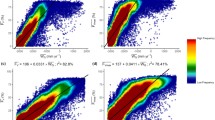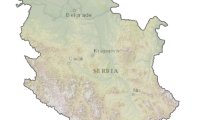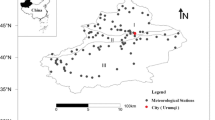Abstract
This work presents a modelling study where monthly-based climate data are used to estimate the Normalized Difference Vegetation Index (NDVI). The latter is a measure of vegetation greenness, usually derived from satellite-driven information. A model was developed to link NDVI data to rainfall and temperature measures. The test area was a 3 × 3 km grid centred to the top of Monte Pino hill (Southern Italy), for which multi-year (from 1996 to 2004) climate and satellite-derived NDVI data were available. The simulated NDVI data compared well with the remote-sensed measurements (e.g. modelling efficiency ∼0.80), thus showing a strong linking between vegetation greenness and climate patterns in spite of the many disturbances exerted from farming. The model was used to reconstruct an extended series of monthly NDVI values for a period antecedent 1996 (1972–1995). The analysis of long-term anomalies indicated a positive trend of NDVI over time, consistent with the air temperature increase registered in the same period.
Similar content being viewed by others
References
Aslan, Z., Sogut, A., & Okcu D. (2005). Spatial and temporal variations of water erosion, aridity and vegetation. Geophysical Research Abstracts, 7, EGU05-A-11135.
Bachelet, D., Neilson, R. P., Lenihan, J. M., & Drapek, R. J. (2001). Climate change effects on vegetation distribution and carbon budget in the United States. Ecosystems, 4, 164–185.
Baldi, M., Pasqui, M., Cesarone, F., & De Chiara, G. (2005). Heat waves in the Mediterranean region: analysis and model results. Paper presented at the 16th Conference on Climate Variability and Change, 85th Annual Meeting of the American Meteorological Society, San Diego, January.
Bannari, A., Morin, D., Bonn, F., & Huete, A. R. (1995). A review of vegetation indices. Remote Sensing Reviews, 13, 95–120.
Barboni, D., Harrison, S. P., Bartlein, P. J., New, M., Prentice, I. C., Sanchez-Goni, M.-F., Davis, B., & Stevenson, A. C. (2004). Relationships between plant traits and climate in the Mediterranean region: A pollen data analysis. Journal of Vegetation Science, 15, 635–646.
Belda, F., & Meliá, J. (2000). Relationships between climatic parameters and forest vegetation: application to burned area in Alicante (Spain). Forest Ecology and Management, 135, 195–204.
Blasi, C., Paura, B., & Mazzoleni, S. (1988). Proposta per una regionalizzazione fitoclimatica della Regione Campania. In Proceedings of the 2° “Methodological Approaches for the Explanation of the Mediterranean Physical and Biological Environment”, Lecce 15–17 Novembre 1988. Orantes editions, pp. 63–82.
Bradley, B. A., & Mustard, J. F. (2005). Identifying land cover variability distinct from land cover change: Cheatgrass in the Great Basin. Remote Sensing of Environment, 94, 204–213.
Brovkin, V., Ganopolski, A., & Svirezhev, Y. (1997). A continuous climate-vegetation classification for use in climate-biosphere studies. Ecological Modelling, 101, 251–261.
Buermann, W., & Dong, J. (2001). Evaluation of the utility of satellite-based vegetation leaf area index for climate simulation. Journal of Climate, 14, 3536–3550.
Cannizzaro, G., Maselli, F., Carotu, L., & Bottai, L. (2002). Use of NOOA-AVHRR NDVI data for climatic characterization of Mediterranean areas. In N. A. Geeson, C. J. Brandt, & J. B. Thornes (Eds.) Mediterranean desertification (pp. 47–54). New York: Wiley & Sons Ltd.
Caroti, L., Maselli, F., & Serafini, R. (1995). Valutazione dell’informazione agrometeorologica contenuta in profili NOAA-NDVI. In A. Zaghi & M. Gomarasca (Eds.), Proceedings of VII AIT National Congress (pp. 487–492), Chieri, October.
Castellvi, F., Stöckle, C. O., Perez, P. J., & Ibañez, M. (2001). Comparison of methods for applying the Priestley-Taylor equation at a regional scale. Hydrological Processes, 15, 1609–1620.
Cuomo, V., Lanfredi, M., Lasaponara, R., Macchiato, M. F., & Simoniello, T. (2001). Detection of interannual variation of vegetation in middle and southern Italy during 1985–1999 with 1 km NOAA AVHRR NDVI data. Journal of Geophysical Research, 106, 17863–17876.
Dale, V. H., Joyce, L. A., McNulty, S., & Neilson, R. P. (2000). The interplay between climate change, forest, and disturbances. Science of the Total Environment, 262, 201–204.
Diodato, N. (2005). The influence of topographic co-variables on the spatial variability of precipitation over little regions of complex terrain. International Journal of Climatology, 25, 351–363.
Diodato, N., & Bellocchi, G. (2007a). Modelling reference evapotranspiration over complex terrains from minimum climatological data. Water Resources Research, 43, DOI 10.1029/2006WR005405.
Diodato, N., & Bellocchi, G. (2007b). Modelling solar radiation over complex terrains using monthly climatological data. Agricultural and Forest Meteorology, 144, 111–126.
Diodato, N., & Ceccarelli, M. (2005). Environinformatics in ecological risk assessment of agroecosystems pollutant leaching. Stochastic Environmental Research and Risk Assessment, 19, 292–300.
Di Pasquale, G., Di Martino, P., & Mazzoleni, S. (2004). Forest history in the Mediterranean region. In S. Mazzoleni, G. Di Martino, & F. Rego (Eds.) Recent dynamics of the Mediterranean vegetation and landscape (pp. 13–20). Chichester: Wiley & Sons Ltd.
Doraiswamy, P. C., Zara, P., & Stern, A. (2000). Satellite remotely sensed data application in estimating crop condition and yields. In M. S. Srinivas (Ed.) Remote sensing applications (pp. 229–240). New Delhi: Narosa Publishing House.
Du Plessis, W. P. (1999). Linear regression relationships between NDVI, vegetation and rainfall in Etosha National Park, Namibia. Journal of Arid Environments, 42, 235–260.
Elmore, A. J., Mustard, J. F., & Manning, S. J. (2003). Regional patterns of plant community response to changes in water: Owens Valley, California. Ecological Applications, 13, 443–460.
Evans, J., & Geerken, R. (2004). Discrimination between climate and human-induced dryland degradation. Journal of Arid Environments, 57, 535–554.
Fila, G., Bellocchi, G., Donatelli, M., & Acutis, M. (2003). IRENE_DLL: object-oriented library for evaluating numerical estimates. Agronomy Journal, 95, 1330–1333.
Foody, G. M. (2003). Geographical weighting as a further refinement to regression modelling: An example focused on the NDVI–rainfall relationship. Remote Sensing of the Environment, 88, 283–293.
Foody, G. M., & Curran, P. J. (1994). Estimation of tropical forest extent and regenerative stage using remotely sensed data. Journal of Biogeography, 21, 223–244.
Friedl, M. A., McIver, D. K., Hodges, J. C. F., Zhang, X. Y., Muchoney, D., & Strahler, A. H., et al. (2002). Global land cover mapping from MODIS: Algorithms and early results. Remote Sensing of Environment, 83, 287–302.
Garcia, M., Raes, D., Allen, R., & Herbas, C. (2004). Dynamics of reference evapotranspiration in the Bolivian highlands (Altiplano). Agricultural and Forest Meteorology, 125, 67–82.
Gutman, G. G. (1999). On the use of long-term global data of land reflectances and vegetation indices derived from the advanced very high resolution radiometer. Journal of Geophysical Research, 104, 6241–6256.
Herrmann, S. M., Anyamba, A., & Tucker, C. J. (2005). Recent trends in vegetation dynamics in the African Sahel and their relationship to climate. Global Environmental Change, 15, 394–404.
Hess, T., Stephens, W., & Thomas, G. (1996). Modelling NDVI from decadal rainfall data in the North East Arid Zone of Nigeria. Journal of Arid Environments, 48, 249–261.
Hunter, I., & Schuck, A. (2002). Increasing forest growth in Europe – possible causes and implications for sustainable fret management. Plant Biosystems, 136, 133–142.
Kidwell, K. B. (1995). NOAA polar orbiter data user’s guide. Washington, D.C.: National Oceanic and Atmospheric Administration.
Kutiel, P., Kutiel, H., & Lavee, H. (2000). Vegetation response to possible scenarios of rainfall variations along a Mediterranean-extreme arid climatic transect. Journal of Arid Environments, 34, 133–185.
Larcher, W. (1996). Physiological plant ecology. New York: Springer.
Loague, K., & Green, R. E. (1991). Statistical and graphical methods for evaluating solute transport models: overview and application. Journal of Contaminant Hydrology, 7, 51–73.
Maselli, F. (2004). Monitoring forest conditions in a protected Mediterranean coastal area by the analysis of multiyear NDVI data. Remote Sensing of Environment, 89, 423–433.
Maselli, F., & Chiesi, M. (2006). Integration of multi-source NDVI data for the estimation of Mediterranean forest productivity. International Journal of Remote Sensing, 27, 55–72.
McR Holm, A., Cridland, S. W., & Roderick, M. L. (2003). The use of time-integrated NOAA NDVI data and rainfall to assess landscape degradation in the arid shrubland of Western Australia. Remote Sensing of Environment, 85, 145–158.
Meza, F., & Varas, E. (2000). Estimation of mean monthly solar radiation as a function of temperature. Agricultural and Forest Meteorology, 100, 231–241.
Minor, T. B., Lancaster, J., Wade, T. G., Wickham, J. D., Whitford, W., & Jones, B. K. (1999). Evaluating changes in rangeland condition using multitemporal AVHRR data and geographic information system analysis. Environmental Monitoring and Assessment, 59, 211–223.
Mouat, D., Lancaster, J., Wade, T., Wickham, J., Fox, C., Kepner, W., & Ball, T. (1997). Desertification evalauted using an integrated environmental assessment model. Environmental Monitoring and Assessment, 48, 139–156.
Moulin, S., & Guérif, M. (1999). Impacts of model parameter uncertainties on crop reflectance estimates: A regional case study on wheat. International Journal of Remote Sensing, 20, 213–218.
Myneni, R. B., Keeling, C. D., Tucker, C. J., Asrar, G., & Nemani, R. R. (1997). Increased plant growth in the northern high latitudes from 1981 to 1991. Nature, 386, 698–701.
Nemani, R., Pierce, L., Running, S. N., & Goward, S. N. (1993). Developing satellite-derived estimates of surface moisture status. Journal of Applied Meteorology, 32, 548−557.
Osborne, C. P. (2004). Modelling the ecology of plants. In J. Wainwright, & M. Mulligan (Eds.) Environmental modelling (pp. 143–155). Chichester: John Wiley & Sons Ltd.
Osborne, C. P., & Woodward, F. I. (2001). Biological mechanism underlying recent increases in the NDVI of Mediterranean shrublands. International Journal of Remote Sensing, 22, 1895–1907.
Park, S., Feddema, J. J., & Egbert, S. L. (2004). Impacts of hydrologic soil properties on drought detection with MODIS thermal data. Remote Sensing of Environment, 89, 53–62.
Pettorelli, N., Vik, J. O., Mysterud, A., Gaillard, J. M., Tucker, C. J., & Stenseth, N. (2005). Using the satellite-derived NDVI to assess ecological responses to environmental change. Trends in Ecology and Evolution, 20, 503–510.
Prasad, V. K., Anuradha, E., & Badarinath, K. V. S. (2005). Climatic controls of vegetation in four contrasting forest types of India – evaluation from National Oceanic and Atmospheric Administration’s Advanced Very High Resolution Radiometer datasets (1990–2000). International Journal of Biometeorology, 50, 6–16.
Refsgaard, J. C., & Henriksen, H. J. (2004). Modelling guidelines - terminology and guiding principles. Advances in Water Resources, 27, 71–82.
Salinas-Zavala, C. A., Douglas, A. V., & Diaz, H. F. (2002). Interannual variability of NDVI in nortwest Mexico. Associated climatic mechanism and ecological implications. Remote Sensing of Environment, 82, 417–430.
Scanlon, T. M., Albertson, J. D., Caylor, K. K., & Williams, C. A. (2002). Determining land surface fractional cover from NDVI and rainfall time series for a Savanna ecosystem. Remote Sensing of Environment, 82, 376–388.
Schmidt, H., & Karnieli, A. (2000). Remote sensing of the seasonal variability of vegetation in a semi-arid environment. Journal of Arid Environments, 45, 43–59.
Schulze, R. (2000). Transcending scales of space and time in impact studies of climate and climate change on agrohydrological responses. Agriculture Ecosystems & Environment, 82, 185–212.
Shevenell, L. (1999). Regional potential evapotranspiration in arid climates based on temperature, topography and calculated solar radiation. Hydrological Processes, 13, 577–596.
Slayback, D. A., Pinzon, J., Los, S. O., & Tucker, C. J. (2003). Northern hemisphere photosynthetic trends 1982–99. Global Change Biology, 9, 1–15.
Snyder, K. A., & Tartowski, S. L. (2006). Multi-scale temporal variation in water availability: implications for vegetation dynamics in arid and semi-arid ecosystems. Journal of Arid Environments, 65, 219–234.
Soil Survey Staff (1999). Soil taxonomy: a basic system of soil classification for making and interpreting soil surveys. Washington, DC: United States Department of Agriculture Soil Conservation Service.
Suzuki, R., Nomaki, T., & Yasunari, T. (2001). Spatial distribution and its seasonality of satellite-derived vegetation index (NDVI) and climate in Siberia. International Journal of Climatology, 21, 1321–1335.
Suzuki, R., Nomaki, T., & Yasunari, T. (2003). West–east contrast of phenology and climate in northern Asia revealed using a remotely sensed vegetation index. International Journal of Biometeorology, 47, 126–138.
Thornley, J. H. M., & Cannel, M. G. R. (1996). Temperate forest responses to carbon dioxide, temperature and nitrogen: a model analysis. Plant Cell and Environment, 20, 1123–1134.
Tucker, C. J. (1979). Red and photographic infrared linear combinations for monitoring vegetation. Remote Sensing of Environment, 8, 127–150.
Tucker, C. J., Slyback, D. A., Pinzon, J. E., Los, S. O., Myneni, R. B., & Taylor, M. G. (2001). Higher northern latitude NDVI and growing season trends from 1982–1999. International Journal of Biometeorology, 45, 184–190.
Verstraeten, W., Veroustraete, F., van der Sande, C., Grootaers, I., & Feyen, J. (2006). Soil moisture retrieval using thermal inertia, determined with visible and thermal spaceborne data, validated for European forests. Remote Sensing of Environment, 101, 299–314.
Vetter, M., Wirth, C., Bottcher, H., Churkina, G., Schulze, E. D., Wutzler, T., & Weber, G. (2005). Partitioning direct and indirect human-induced effects on carbon sequestration of managed coniferous forest using model simulations and forest inventories. Global Change Biology, 11, 810–827.
Vicente-Serrano, S. M., Cuadrat-Prats, M., & Romo, A. (2006). Aridity influence on vegetation patterns in the middle Ebro Valley (Spain): evaluation by means of AVHRR images and climate interpolation techniques. Journal of Arid Environments, 66, 353–375.
Vogelmann, J. E., Howard, S. M., Yang, L., Larson, C. R., Wylie, B. K., & van Driel, J. N. (2001). Completion of the 1990’s National Land Cover Data Set for the conterminous United States. Photogrammetric Engineering and Remote Sensing, 67, 650–662.
Watson, R. T., Zinyowera, M. C., Moss, R. H., & Dokken, D. J. (1998). The regional impacts of climate change: an assessment of vulnerability, a special report of IPCC working group II. Cambridge: Cambridge University Press.
Wegehenkel, M., Jochheim, H., & Kersebaum, K. C. (2005). The application of simple methods using remote sensing data for the regional validation of a semidistributed hydrological catchment model. Physics and Chemistry of the Earth, 30, 575−587.
Weisse, R., & Oestreicher, R. (2001). Reconstruction of potential evaporation for water balance studies. Climate Research, 16, 123–131.
Wickham, J. D., O’Neill, R. V., & Jones, K. B. (2000). A geography of ecosystem vulnerability. Landscape Ecology, 15, 495–504.
Widen, N. (2004). Assessing the accuracy of land surface characteristics estimated from multi-angular remotely sensed data. International Journal of Remote Sensing, 6, 1105–1117.
Woodward, F. I., & Osborne, C. P. (2000). The representation of root processes in models addressing the responses of vegetation to global change. New Phytologist, 147, 223–232.
Xu, J., Haginoya, S., Saito, K., & Motoya, K. (2005). Surface heat balance and pan evaporation trends in Eastern Asia in the period 1971–2000. Hydrological Processes, 19, 2161–2186.
Xu, C.-Y., & Singh, V. P. (2000). Evaluation and generalization of radiation-based methods for calculating evaporation. Hydrological Processes, 14, 339–349.
Author information
Authors and Affiliations
Corresponding author
Rights and permissions
About this article
Cite this article
Diodato, N., Bellocchi, G. Modelling vegetation greenness responses to climate variability in a Mediterranean terrestrial ecosystem. Environ Monit Assess 143, 147–159 (2008). https://doi.org/10.1007/s10661-007-9964-z
Received:
Accepted:
Published:
Issue Date:
DOI: https://doi.org/10.1007/s10661-007-9964-z




